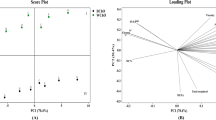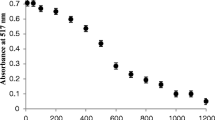Abstract
Hawk tea and camellia oil widely consumed in China. In this work, the addition of 3 hawk tea extracts, namely hawk bud tea extract (HBE), hawk primary leaf tea extract and hawk mature leaf tea extract (HME), to camellia oil was evaluated as potential antioxidants against oxidation under microwave heating. Quality parameters (acid value, peroxide value, K270 and K232), fatty acid composition, total phenols and antioxidant activity were investigated during different microwave heating exposure time (0, 3, 6, and 10 min). Microwave heating significantly increased the peroxide value, K270 and K232 of camellia oil as a result of oxidation. The addition of hawk tea extracts increased the availability of total phenol content in the samples, and counteracted the rise of quality parameter values, particularly during camellia oil microwave exposure beyond 6 min. In addition, HBE and HME could effectively protect camellia oil against polyunsaturated fatty acids loss, while HPM exhibited a reverse behavior. The correlation analysis between quality parameters, antioxidant activity and total phenols content shown that polyphenols were the important constituents to contribute the resistance of camellia oil oxidation.



Similar content being viewed by others
References
Aysel MB, Bayrak A, Kiralan M, Ozbucak T (2013) Individual and combined use of rosemary and origanum in soybean oil as natural antioxidants. Int J Food Prop 16:995–1001
Balasundram N, Sundram K, Samman S (2006) Phenolic compounds in plants and agri-industrial by-products: antioxidant activity, occurrence, and potential uses. Food Chem 99:191–203
Ben-Ali M, Dhouib K, Damak M, Allouche N (2013) Stabilization of sunflower oil during accelerated storage: use of basil extract as a potential alternative to synthetic antioxidants. Int J Food Prop 17:1547–1559
Casal S, Malheiro R, Sendas A, Oliveira BPP, Pereira JA (2010) Olive oil stability under deep-frying conditions. Food Chem Toxicol 48:2972–2979
Chen L, Cheng W, Hu C, Jin Y, Li R, Li J (2004) Study on anti-inflammatory effects of total flavonoids of Litsea coreana Leve. Var. Acta Universitatis Medicinalis Anhui 39:439–442
Francis G, Kerem Z, Makkar HP, Becker K (2002) The biological action of saponins in animal systems: a review. Br J Nutr 88:587–605
Hiromi Y, Izumi K, Goro K (1992) Participation of free fatty acids in the oxidation of purified soybean oil during microwave heating. J Am Oil Chem Soc 69:1136–1140
Ignat I, Volf I, Popa VI (2011) A critical review of methods for characterisation of polyphenolic compounds in fruits and vegetables. Food Chem 126:1821–1835
Lee CP, Yen GC (2006) Antioxidant activity and bioactive compounds of tea seed (Camellia oleifera Abel.) oil. J Agr Food Chem 54:779–784
Lee J, Koo N, Min DB (2004) Reactive oxygen species, aging, and antioxidative nutraceuticals. Compr Rev Food Sci F 3:21–33
Lee CP, Shih PH, Hsu CL, Yen GC (2007) Hepatoprotection of tea seed oil (Camellia oleifera Abel.) against CCl4-induced oxidative damage in rats. Food Chem Toxicol 45:888–895
Li X, Shen S, Deng J, Li T, Ding C (2014) Antioxidant activities and functional properties of tea seed protein hydrolysates (Camellia oleifera Abel.) influenced by the degree of enzymatic hydrolysis. Food Sci Biotechnol 23:2075–2082
Liao Z, Yin D, Wang W, Zeng G, Liu D, Chen H, Huang Q, He M (2009) Cardioprotective effect of sasanquasaponin preconditioning via bradykinin-NO pathway in isolated rat heart. Phytother Res 23:1146–1153
Liu J (2003) Effect of Glede Tea to blood sugar and blood fat of rats. Chin J Pract Chin Modern Med 1:2057–2058
Lu YX, Zhang Q, Li J, Sun YX, Wang LY, Cheng WM, Hu XY (2010) Antidiabetic effects of total flavonoids from Litsea Coreana leve on fat-fed, streptozotocin-induced type 2 diabetic rats. Am J Chin Med 38:713–725
Malheiro R, Oliveira I, Vilas-Boas M, Falcão S, Bento A, Pereira JA (2009) Effect of microwave heating with different exposure times on physical and chemical parameters of olive oil. Food Chem Toxicol 47:92–97
Malheiro R, Casal S, Lamas H, Bento A, Pereira JA (2012) Can tea extracts protect extra virgin olive oil from oxidation during microwave heating? Food Res Int 48:148–154
Malheiro R, Rodrigues N, Manzke G, Bento A, Pereira JA, Casal S (2013) The use of olive leaves and tea extracts as effective antioxidants against the oxidation of soybean oil under microwave heating. Ind Crop Prod 44:37–43
Mukhtar H, Ahmad N (2000) Tea polyphenols: prevention of cancer and optimizing health. Am J Clin Nutr 71:1698–1702
Oyaizu M (1986) Studies on products of browning reaction: antioxidative activity of products of browning reaction. Jpn J Nutr 44:307–315
Rajapakse N, Mendis E, Jung WK, Je JY, Kim SK (2005) Purification of a radical scavenging peptide from fermented mussel sauce and its antioxidant properties. Food Res Int 38:175–182
Roy LG, Arabshahi-Delouee S, Urooj A (2010) Antioxidant efficacy of mulberry (Morus indica L.) leaves extract and powder in edible oil. Int J Food Prop 13:1–9
Wang J, Li J, Zou Y, Cheng W, Lu C, Zhang L, Ge J, Huang C, Jin Y, Lv X, Hu C, Liu L (2009) Preventive effects of total flavonoids of Litsea coreana leve on hepatic steatosis in rats fed with high fat diet. J Ethnopharmacol 121:54–60
Wang Y, Huang S, Shao S, Qian L, Xu P (2012) Studies on bioactivities of tea (Camellia sinensis L.) fruit peel extracts: antioxidant activity and inhibitory potential against α-glucosidase and α-amylase in vitro. Ind Crop Prod 37:520–526
Yoshida H, Hirakawa Y, Tomiyamaa Y, Mizushina Y (2003) Effects of microwave treatment on the oxidative stability of peanut (Arachis hypogaea) oils and the molecular species of their triacylglycerols. Eur J Lipid Sci Tech 105:351–358
Yuan M, Jia X, Ding C, Yuan S, Zhang Z, Chen Y (2014) Comparative studies on bioactive constituents in hawk tea infusions with different maturity degree and their antioxidant activities. Sci World J 2014:1–7
Acknowledgements
The authors sincerely appreciate the support of Xuejing Jia and Qinfen Zhou during this experiment, and thank anonymous reviewers for their helpful suggestions.
Author information
Authors and Affiliations
Corresponding author
Rights and permissions
About this article
Cite this article
Xu, Z., Li, X., Feng, S. et al. Antioxidant effect of hawk tea extracts on camellia oil oxidation during microwave heating. J Consum Prot Food Saf 13, 391–398 (2018). https://doi.org/10.1007/s00003-018-1167-8
Received:
Accepted:
Published:
Issue Date:
DOI: https://doi.org/10.1007/s00003-018-1167-8




